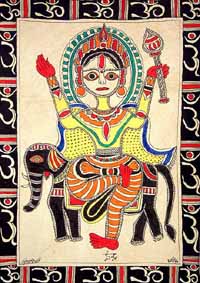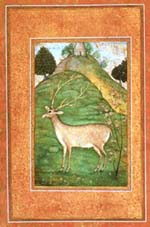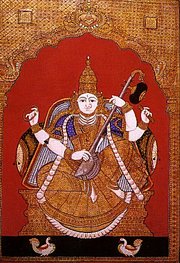Indian Painting
 Indian Painting has always occupied a special place in Indian art. Indian paintings are diverse rich and varied from one era to another. The themes are different with different sources of inspirations. The earliest Indian paintings were the rock paintings of the pre-historic times in places like Bhimbetka. Such works continued for several millennia. Other earlier examples can also be given like the Ajantha and Ellora caves that are famous for their frescoes.
Indian Painting has always occupied a special place in Indian art. Indian paintings are diverse rich and varied from one era to another. The themes are different with different sources of inspirations. The earliest Indian paintings were the rock paintings of the pre-historic times in places like Bhimbetka. Such works continued for several millennia. Other earlier examples can also be given like the Ajantha and Ellora caves that are famous for their frescoes.
Indian Paintings can be broadly classified as murals and miniatures. Murals are huge works executed on the walls of solid structures, as in the Ajanta Caves. Miniature paintings are made on a smaller scale on perishable material such as paper or cloth.
Then there have also been major themes or influences which have been the source of inspirations for the artists who used them for their paintings. Some of the painting styles styles are mughal, Tanjaore, Ragamala etc all of which had their own set of characteristics, composition and inspirations. Then also in today's age we have concepts like pseudorealsim and modern art that have all been able to form newer and different styles of painting.
Murals Paintings
The period of history for Indian murals is around 2 century BC to 10 century AD. There are said to be more than 20 places where there are known collections of murals from the above periodsin natural caves and rock cut chambers. The more standout achievements include the caves in of Ajantha, Ellora, Armamalai Cave, Bagh Sittanavasal etc. The murals reflect different themes like Bhuddism or Hindu religions.
Miniature Paintings
Indian miniatures can be classified on many themes over the thousandths of years. The culture of wall paintings surfaced the need for having miniature paintings during the 11th and 12th centuries. They initially figured in the form of manuscripts. Over the year many styles have developed across different places in India. Here is a list of few of the interesting and popular styles.
Eastern Indian and Western Indian Painting
The contents of these manuscripts included literature on Buddhism & Jainism which developed around the 10th or 11th century. Buddhist divinities and scenes from the life of Buddha were painted on palm leaf manuscripts. In eastern India, the principal centres of artistic and intellectual activities of the Buddhist religion were Nalanda, Odantapuri, Vikramshila and Somarpura .
Around the 12th century miniatures where found in Jain manuscripts which were around 2 to 4 inches in size and around 14th century they began to replace palm leaves with paper. Common paper manuscripts include Kalpasutra of Bhadrabahu. The Jain style of painting experienced good development by the 15 the century and by the 16 th century Hindu illustrated manuscripts of the Bhagavata Purana and Gitagovinda of Jayadeva appeared in Western India.
Mugal Paintings
 The Mughal style had its origins during the time of Akbar. The emperor having a keen interest in art promoted various art forms to evolve and flourish. The style is a combination of indigenous Indian style and Safavid style of Persian painting that gave it supple naturalism characterized by delicate drawings.
The Mughal style had its origins during the time of Akbar. The emperor having a keen interest in art promoted various art forms to evolve and flourish. The style is a combination of indigenous Indian style and Safavid style of Persian painting that gave it supple naturalism characterized by delicate drawings.
High on aesthetic appeal it was usually confined to the aristocracy. Some of the examples are Tuti-nama and the Hamzanama . Rulers like Shah Jahan and Jahangir further promoted Mughal art it flourished developing deeper techniques and influences also from other styles. Some of the famous painters during this era are Mohammad Faqirullah Khan, Mir Hashim, Muhammad Nadir, Bichitr, Chitarman, Anupchhatar and Manohar.
Rajput Painting
Rajput Painting is also known by the name of Rajasthani painting which flourished during the 18th century in the royal courts of Rajputana. The themes of the paintings were mostly religious and love subjects, based on Lord Rama and Lord Krishna.Bold outlines and brilliant colours are characteristic of the Rajasthani paintings. It has influences from Mughal painting. Rajput painting was characterized by its use of a limited colours, shallow space and decorative splendour.
Tanjore Painting
 Tanjore painting is an elegant and rich looking style of painting which has its origins from South India particularly native to the town of Thanjavur after which it is named. It dates back to 1600 AD when Nayakas of Tanjavur encouraged art. Its unique compared to the other techniques. The paintings are generally based on the Hindu Gods and are depicted as excerpts from various contexts in mythology.
Tanjore painting is an elegant and rich looking style of painting which has its origins from South India particularly native to the town of Thanjavur after which it is named. It dates back to 1600 AD when Nayakas of Tanjavur encouraged art. Its unique compared to the other techniques. The paintings are generally based on the Hindu Gods and are depicted as excerpts from various contexts in mythology.
The process consists of a basic sketch on a wooden board that's wrapped in cloth. Then chalk powder is mixed with a water-soluble adhesive agent which is applied on the cloth. The drawing is then decorated with semi-precious stones also known as Jaipur stones.
Laces or threads are also used to decorate the jewellery. On top of this, the gold foils are pasted. Finally, dyes and colours are used to add colour and texture to the figures in the paintings. Tanjore paintings are still very popular today and kind of detail that goes in them makes the paintings really beautiful.
Bengal School of Painting
During the British Raj in the early 20th century another style called the Bengal School Of Art flourished. During that time there was a renewed upsurge of nationalist fervour. This resulted in the search and revitalisation of Indian cultural history and spirituality, albeit one that was expressed not through the pictorial vocabulary of the foreign rulers but by reviving indigenous techniques and material.
Abanindranath Tagor looked to ancient murals and medieval Indian miniature paintings as a source of inspiration. The style developed by him was by many of his students and others who formed the nationalist art movement which came to be called the Bengal School. Even though the style and philosophy spread well beyond the borders of Bengal. They sought to develop an indigenous yet a style that is modern in art as a medium to the call for 'Swadeshi'. The style began to decline during the 1920's with the emergence of modern art in Indian painting.